
The Brassicales are an order of flowering plants, belonging to the eurosids II group of dicotyledons under the APG II system. One character common to many members of the order is the production of glucosinolate compounds. Most systems of classification have included this order, although sometimes under the name Capparales.
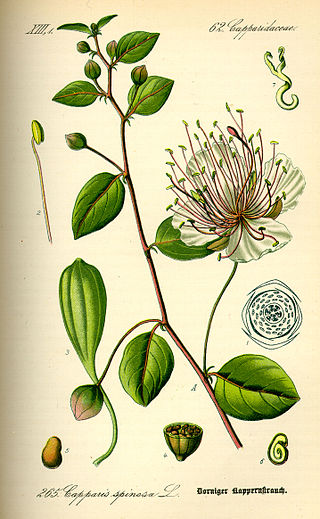
Capparis spinosa, the caper bush, also called Flinders rose, is a perennial plant that bears rounded, fleshy leaves and large white to pinkish-white flowers.
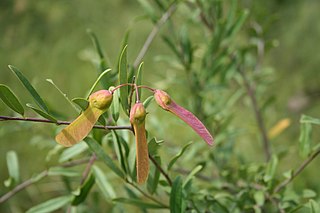
The Polygalaceae or the milkwort family are made up of flowering plants in the order Fabales. They have a near-cosmopolitan range, with about 27 genera and ca. 900 known species of herbs, shrubs and trees. Over half of the species are in one genus, Polygala, the milkworts.
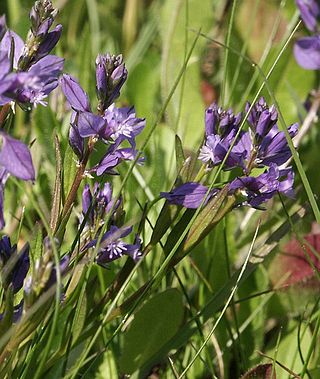
Polygala is a large genus of flowering plants belonging to the family Polygalaceae. They are commonly known as milkworts or snakeroots. The genus is distributed widely throughout much of the world in temperate zones and the tropics. The genus name Polygala comes from the ancient Greek "much milk", as the plant was thought to increase milk yields in cattle.

Mirbelia is a plant genus belonging to the family Fabaceae and is endemic to Australia, occurring in every mainland state except South Australia. Plants in the genus Mirbelia are prickly, perennial shrubs with simple, sometimes sharply-pointed leaves, or the leaves absent. The flowers are arranged singly or in groups in leaf axils or on the ends of branches, the sepals joined at the base with five teeth. The petals are usually red, orange, purplish or bluish and the fruit is an inflated pod.
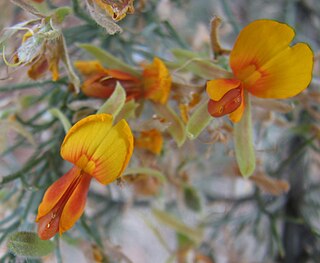
Jacksonia is a genus of about 73 species of mostly leafless, broom-like shrubs or small trees in the flowering plant family Fabaceae. The genus is endemic to Australia and species occur in a range of habitats in all Australian states except Victoria, South Australia and Tasmania.
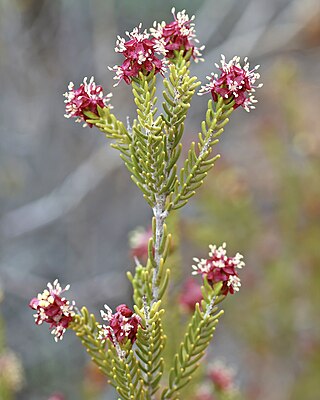
Passerina is a genus in the plant family Thymelaeaceae. They are ericoid bushes growing largely in fynbos and other Southern African scrub habitats.

Comesperma is a genus of shrubs, herbs and lianas in the family Polygalaceae. The genus is endemic to Australia. It was defined by the French botanist Jacques Labillardière in his 1806 work Novae Hollandiae Plantarum Specimen. The genus name is derived from the Ancient Greek words come ("hair") and sperma ("seed"), and relates to the seeds bearing tufts of hair. The genus is distributed over southern Australia, particularly in the southwest of Western Australia, where 19 species are found. 24 species have been described.
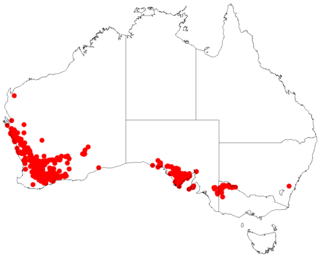
Comesperma scoparium, commonly known as broom milkwort, is a small broom-like shrub of the family Polygalaceae. It usually grows to between 0.3 and 1.2 metres high and produces blue flowers between February and November in its native range.
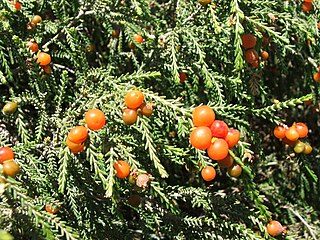
Passerina ericoides, the Christmas berry, is a threatened species of plant in the family Thymelaeaceae, genus Passerina. It is indigenous to the coastal fynbos areas in and around the city of Cape Town, South Africa.

Monotoca scoparia, commonly known as prickly broom heath, is a widespread native species across south-eastern Australia. Monotoca scoparia was formerly in the family Epacridaceae but now belongs to the family Ericaceae. Monotoca is an endemic Australian genus with 17 described species occurring in all states.
Moutabea is a neotropical genus of Polygalaceae with about 10 species. It was first described in 1775 by Jean Aublet.
Muraltia flanaganii is a plant species in the milkwort family (Polygalaceae). It is native to grasslands and moorlands with altitudes between 1,160 and 3,355 metres in southern and eastern Africa. It is a perennial shrub with a height of 20 to 100 centimetres which produces white, pink, or purple flowers. Its leaves are 3 to 8 millimetres long, 0.5 to 1 millimetre wide, and obtuse or apiculate, ending at a needle-like point. The surface of the leaves are glabrous and rough to the touch. According to the Red List of South African Plants, the species is of least ecological concern. It was first described in the Journal of Botany, British and Foreign by Harry Bolus.
Muraltia flanaganii is a plant species in the milkwort family (Polygalaceae) that is endemic to rocky flats about 5 metres (16 ft) above sea level in the southwestern part of Cape Province, South Africa. It is a perennial subshrub with a height between 6 and 20 centimetres which branches mainly at its base. The plant's clustered leaves are softly-haired and have sharp tips. It produces pink flowers which are also stalkless. It has been listed by the Red List of South African Plants as endangered since 2007 due to invasive species and habitat loss. It was first written about by Margaret Levyns in 1954 in the Journal of South African Botany. It was named "minuta", the Latin word for "small", in reference to the plant's small size.
Atroxima afzeliana is a species of plant in the milkwort family (Polygalaceae). It is endemic to rainforests and forest fringes with altitudes below 200 metres (660 ft) in Western Tropical Africa. It was first described in 1868 by Daniel Oliver, at which point it was described as a new Carpolobia or a new genus. In 1905, Otto Stapf classified it into the atroxima genus.

Atroxima is a plant genus in the milkwort family (Polygalaceae). It is endemic to Western Tropical Africa. It was first described in 1905 by Otto Stapf in the Journal of the Linnean Society. It was initially in the Polygalaeae tribe before being split off with Carpolobia in 1992 to form the Carpolobieae tribe. They are lianas or liana-like shrubs which produce shiny, orange, fleshy uni- to tri-locular berries, these can have an area of up to 5 by 5 by 4 centimetres.
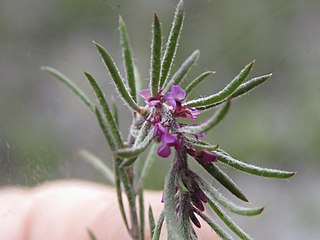
Muraltia bolusii is a plant species in the milkwort family (Polygalaceae). It is endemic to sandy coastal flatland with altitudes below 500 metres (1,600 ft) in Western Cape, South Africa. It was first described in 1954 by Margaret Levyns in the Journal of South African Botany. The Red List of South African Plants has listed it as endangered since 2007 due to habitat loss caused by nearby urban expansion, crop cultivation, and sand mining, as well as invasive species. Its population is decreasing.

Muraltia heisteria is a shrub in the milkwort family (Polygalaceae) which is native to South Africa and is an emerging invasive species in South Australia. It was first described in 1753 by Carl Linnaeus.

Muraltia orbicularis is a species of flowering plant from the genus Muraltia. The species is endemic to Cape Peninsula in South Africa.















